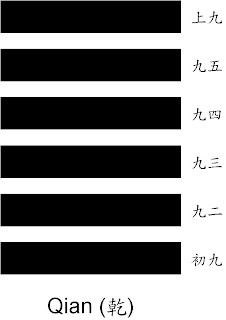
After we apply the Adoption of Earthly Branches and Relatives into a specific hexagram, there are few things we need to check in order to complete the Setting.
1. We will be using “、” to represent Shao-Yang (少陽) and “、、” to represents Shao-Yin (少陰), both of which are not subjected to change. We will also be using “○” to represent Lao-Yang (老陽) and “✕” to represent Lao-Yin (老陰), both of which are subjected to change.
2. Is there any Relative missing? In order to properly decipher WWG, we need to have all the Relatives: the Parent (父母), Sibling (兄弟), Child (子孫), Asset (妻財), and Officer (官鬼). If there is any Relative missing, we need to look it up from the Originating Hexagram of the Chamber (本宮卦, or Ben-Gong Gua).
3. If any of the lines in a hexagram becomes an Active Line (動爻, or Dong-yao), we need to figure out what is the Adoption of Earthly Branches as well as the Relatives of the Changed Line (變爻, or Bian-yao) and recorded it alongside the Active Line.
4. We need to record the date of casting and figure out the Six Celestial Figures (六獸, Liu-shou), namely in sequence, Azure Dragon (青龍, Qing-long), Vermilion Bird (朱雀, Zhu-que), Curved Array (勾陳, Gou-chen), Flying Serpent (螣蛇, Teng-she), White Tiger (白虎, Bai-hu), and Murky Warrior (玄武, Xuan-wu).
Using Zhun-to-Sui (屯之隨) as an example, whereas Water-Thunder Zhun (水雷屯) is the Original Hexagram and River-Thunder Sui (澤雷隨) is the Changed Hexagram. The fourth line of Zhun is changed from a Broken Line (陰爻) into a Solid Line (陽爻). Assuming the date of casting is the day of Wu-shen (戊申).
1. We will be using “、” to represent Shao-Yang (少陽) and “、、” to represents Shao-Yin (少陰), both of which are not subjected to change. We will also be using “○” to represent Lao-Yang (老陽) and “✕” to represent Lao-Yin (老陰), both of which are subjected to change.
2. Is there any Relative missing? In order to properly decipher WWG, we need to have all the Relatives: the Parent (父母), Sibling (兄弟), Child (子孫), Asset (妻財), and Officer (官鬼). If there is any Relative missing, we need to look it up from the Originating Hexagram of the Chamber (本宮卦, or Ben-Gong Gua).
3. If any of the lines in a hexagram becomes an Active Line (動爻, or Dong-yao), we need to figure out what is the Adoption of Earthly Branches as well as the Relatives of the Changed Line (變爻, or Bian-yao) and recorded it alongside the Active Line.
4. We need to record the date of casting and figure out the Six Celestial Figures (六獸, Liu-shou), namely in sequence, Azure Dragon (青龍, Qing-long), Vermilion Bird (朱雀, Zhu-que), Curved Array (勾陳, Gou-chen), Flying Serpent (螣蛇, Teng-she), White Tiger (白虎, Bai-hu), and Murky Warrior (玄武, Xuan-wu).
Using Zhun-to-Sui (屯之隨) as an example, whereas Water-Thunder Zhun (水雷屯) is the Original Hexagram and River-Thunder Sui (澤雷隨) is the Changed Hexagram. The fourth line of Zhun is changed from a Broken Line (陰爻) into a Solid Line (陽爻). Assuming the date of casting is the day of Wu-shen (戊申).




















